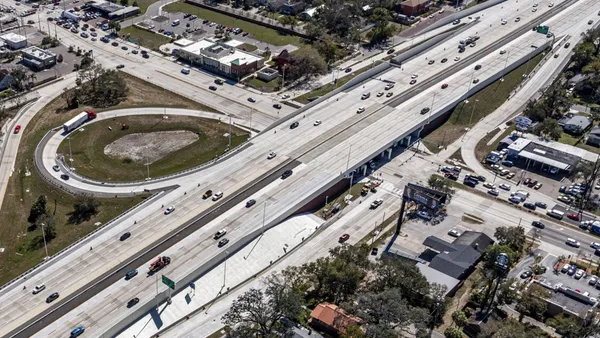Dive Brief:
- The New York chapter of the American Society of Civil Engineers gave the state’s overall infrastructure a C grade, or mediocre condition, according to the 2022 Report Card for New York’s Infrastructure.
- Of the 11 infrastructure categories studied by New York’s civil engineers, two categories are in good condition, six are in mediocre condition and three are in poor condition, according to the report.
- To improve the state’s infrastructure, the ASCE suggested more funding, a reassessment of infrastructure goals due to new commuting patterns, testing new materials and construction techniques and expanding technical training and apprenticeship programs.
Dive Insight:
The ASCE still rates New York state’s infrastructure in mediocre condition, though its 2022 C rating shows a slight improvement from its 2015 grade of C-, according to the report.
Rep. John Katko, R-N.Y., added “there is significant work to be done to improve our infrastructure grades across the board,” in the ASCE release.
The state has placed significant effort in advancing its bridge program, such as the $3.98 billion Governor Mario M. Cuomo Bridge (pictured above) and the reconstruction or replacement of hundreds of smaller spans to improve resilience to flooding events, according to the report. The Cuomo Bridge won bronze in the 2021 Outstanding Civil Engineering Achievement award.
Still, almost 10% of New York state bridges are in poor condition, above the national average of 7%, according to the ASCE.The bridge category received a C- grade, according to the report.
Roads are also facing uncertainty over future federal funding. The Infrastructure Investment and Jobs Act will provide New York with $11.6 billion for federal-aid highway programs and $1.9 billion for bridge replacement and repairs, the largest bridge investment in over 50 years. However, the IIJA is a five-year program and does not guarantee long-term funding allocation.
At the same time, transit networks are facing a $26.6 billion capital funding gap through 2024.
Drinking water investment has also not kept pace with demand. The 20-year need for drinking water infrastructure is estimated at $44.2 billion, but water system revenue has only been growing about the rate of the inflation. Nearly 40% of New York City’s pipes were placed pre-1941, despite the design life of these pipes being 50 to 70 years, according to the report. George Kalkowsky, co-chair of the ASCE committee, reiterated the need to get ahead of maintaining these systems before costs get out of hand.
“We must prioritize these systems to protect New York families and businesses because failing to do so can lead to issues we don’t recognize until it’s too late,” said Kalkowsky in the release. “It is far more cost effective to prioritize maintenance before issues arise.”
About 40% of New York’s 35,000 miles of sewers are more than 60 years old, and about 10% are close to 100 years old, according to the report. Approximately 6.5 billion gallons of untreated combined sewer and stormwater were released in 2017, which can contaminate surface waters and threaten public health.
Here is the full list for New York’s infrastructure grades, according to the ASCE report:
- Overall: C
- Aviation: C+
- Bridges: C-
- Dams: C
- Drinking water: C-
- Public parks: B-
- Ports: C+
- Rail: C
- Roads: D+
- Transit: D+
- Solid waste: B-
- Wastewater: D+













